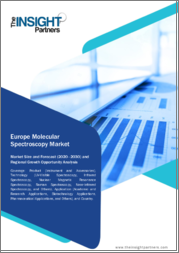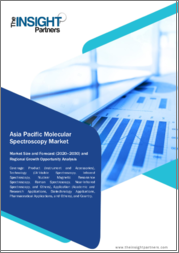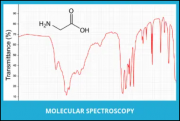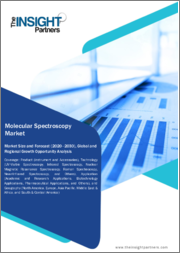
|
시장보고서
상품코드
1516058
세계의 분자 분광법 시장 : 기술별, 최종사용자별, 예측(2024-2032년)Molecular Spectroscopy Market - Technology [Nuclear Magnetic Resonance Spectroscopy (Fourier-transform NMR, Solid-state NMR), UV-Visible (Dual-beam UV-visible, Single-beam UV-visible), Infrared, Near-infrared], End-user, Global Forecast (2024 - 2032) |
||||||
분자 분광법 시장 규모는 기술 발전과 분석 기술 혁신으로 인해 2024년부터 2032년까지 연평균 6%의 CAGR을 기록할 것으로 예측됩니다.
빠른 발전으로 연구자들은 다양한 산업에서 보다 정밀한 분석을 할 수 있게 되었습니다. 의약품 개발, 식품 및 음료, 환경 모니터링 등 품질 관리뿐만 아니라 제약 및 생명공학 분야에서도 분자 이미징에 대한 수요가 증가하고 있습니다. 그 예로, TrinamiX GmbH는 2023년 10월 새로운 Snapdragon(R) 8 Gen 3 레퍼런스 디자인을 탑재한 소비자 분광학 솔루션을 발표했습니다.
연구자들 사이에서 인식과 수용도가 높아지고, 신흥국에서는 제약 및 생명공학 산업이 확대됨에 따라 연구개발 활동에 대한 정부의 재정적 지원이 증가하고 있습니다. 의료 인프라에 대한 투자 증가와 대학 및 연구 기관의 분자 분광법 장비에 대한 수요 증가도 시장 성장의 원동력이 될 것입니다.
분자 분광법 산업은 기술, 최종사용자 및 지역으로 분류됩니다.
기술에 따라 적외선 분광법 부문 시장 규모는 다양한 산업에서 활용도가 높아 2032년까지 높은 CAGR을 기록할 것으로 예상됩니다. 적외선 분광법은 상세한 분자 분석과 비파괴성을 제공하기 때문에 다양한 산업에서 매우 중요합니다. 핸드헬드 장치와 같은 기술의 발전으로 인해 현장 응용 분야에서의 활용이 증가하고 있습니다. 제조 공정 분석 기술(PAT)에 대한 관심이 높아지면서 품질 관리 및 품질 보증의 향상과 함께 이 분야의 성장에 박차를 가하고 있습니다.
최종사용자 측면에서 CRO 부문 분자 분광법 시장은 2024-2032년 동안 신약 개발 및 의약품 개발을 위한 첨단 분석 기술에 대한 의존도가 높아짐에 따라 분자 분광법 시장이 크게 성장할 것으로 예상되며, CRO는 분자 분광 기술을 활용하여 신속하고 정확한 진단, 연구 효율성 향상, 납기 단축을 위해 제약, 바이오테크놀러지, 학계 분광분석 기술을 활용하여 제약, 생명공학, 학술 기관에 위탁 연구 서비스를 제공하고 있습니다.
아시아태평양의 분자 분광법 산업은 제약 및 생명공학 부문의 부상으로 2032년까지 지속적인 성장률을 기록할 것으로 전망됩니다. 의료 인프라에 대한 투자 증가, 연구개발에 대한 정부 이니셔티브의 급증, 의약품 제조의 확대가 현지 제약 및 생명공학 부문의 성장을 견인하고 있습니다. 식품 및 음료(F&B) 분야에서도 품질 관리, 환경 모니터링 및 과학 연구에 공간법이 활용되고 있으며, 이는 지역 시장의 성장을 더욱 촉진하고 있습니다.
목차
제1장 조사 방법과 조사 범위
제2장 주요 요약
제3장 업계 인사이트
- 생태계 분석
- 업계에 대한 영향요인
- 성장 촉진요인
- 제약 기업의 응용과 채용 증가
- 신약 창출에 초점을 맞춘 연구개발 활동 활발화
- 분자 분광법 분야의 기술 진보
- 업계의 잠재적 리스크와 과제
- 분자 분광법의 높은 비용
- 전문 지식과 트레이닝의 필요성
- 성장 촉진요인
- 성장 가능성 분석
- 규제 상황
- Porters 분석
- PESTEL 분석
제4장 경쟁 상황
- 소개
- 기업 매트릭스 분석
- 주요 시장 기업의 경쟁 분석
- 경쟁 포지셔닝 매트릭스
- 전략 대시보드
제5장 시장 추정과 예측 : 기술별, 2021-2032년
- 주요 동향
- 핵자기공명(NMR) 분광법
- 푸리에 변환 NMR 분광법(FTS)
- 고체 NMR 분광법(SSNMR)
- 연속파(CW) NMR 분광법
- 자외 가시 분광법
- 듀얼빔 자외 가시 분광법
- 싱글빔 가시 자외 분광법
- 어레이 기반 자외 가시 분광법
- 적외(IR) 분광법
- 중파장 적외 분광
- 단파장 적외 분광
- 원적외 분광법
- 근적외선 분광법
- 푸리에 변환
- 스캐닝
- 필터 또는 AOTF
- 라만 분광법
- 샘플링법
- 표면 증강 라만 산란
- 칩 증강 라만 산란
- 기타
- 유형별
- 마이크로 라만 분광법
- 프로브형 라만 분광법
- 푸리에 변환 라만 분광법
- 샘플링법
- 기타 기술
제6장 시장 추정과 예측 : 최종사용자별, 2021-2032년
- 주요 동향
- 제약·바이오테크놀러지 기업
- 학술·연구기관
- CRO
- 기타
제7장 시장 추정과 예측 : 지역별, 2021-2032년
- 주요 동향
- 북미
- 미국
- 캐나다
- 유럽
- 독일
- 영국
- 프랑스
- 스페인
- 이탈리아
- 기타 유럽
- 아시아태평양
- 중국
- 일본
- 인도
- 호주
- 기타 아시아태평양
- 라틴아메리카
- 브라질
- 멕시코
- 기타 라틴아메리카
- 중동 및 아프리카
- 남아프리카공화국
- 사우디아라비아
- 기타 중동 및 아프리카
제8장 기업 개요
- Agilent Technologies Inc.
- Bruker Corporation
- Danaher Corporation
- Horiba Ltd.
- Jasco Inc.
- Jeol Ltd.
- Merck KGaA
- PerkinElmer Inc.
- Thermo Fisher Scientific Inc.
- VIAVI Solutions Inc.
Molecular spectroscopy market size is anticipated to register 6% CAGR between 2024 and 2032, owing to technological advancements and innovations in analytical techniques. Rapid advancements have enabled researchers to conduct more precise analysis in various industries. There is growing demand for molecular imaging in pharmaceutical and biotech sectors for drug development, as well as in quality control across food, beverage, and environmental monitoring. To illustrate, in October 2023, TrinamiX GmbH launched its consumer spectroscopy solution powered by the new Snapdragon(R) 8 Gen 3 reference design.
Surging awareness and acceptance among researchers and the expansion of pharmaceutical and biotech industries in emerging economies is increasing the government financial support for R&D activities. Higher investments in healthcare infrastructure, and the rising demand for molecular spectroscopy instruments from universities and research institutes will also drive the market growth.
The molecular spectroscopy industry is classified into technology, end-user and region.
Based on technology, the market size from the infrared spectroscopy segment will witness significant CAGR through 2032, due to its versatility across various industries. Infrared spectroscopy offers detailed molecular analysis and non-destructive nature, making it crucial in various industries. Advances in technology like handheld devices are also boosting usage in field applications. Growing interest in process analysis technology (PAT) in manufacturing along with increased quality control and assurance will add to the segment growth.
With respect to end-user, the molecular spectroscopy market from the CROs segment is slated to generate notable gains during 2024-2032, due to increasing dependence on advanced analytical techniques for drug discovery and development procedure. CROs offer outsourced research services to pharmaceutical, biotech, and academic institutions by utilizing molecular spectroscopy technology for rapid and accurate diagnostics as well as enhancing research efficiency and reducing turnaround time.
Asia Pacific molecular spectroscopy industry will record sustained growth rate through 2032, attributed to rising pharmaceutical and biotechnology sector. Increased investments in healthcare infrastructure, surge in government initiatives for R&D, and expansion of pharmaceutical manufacturing are boosting the local medicine and biotech sector. Spatial methods are also being used in food & beverage (F&B) sector for quality control, environmental monitoring, and scientific research, further driving the regional market growth.
Table of Contents
Chapter 1 Methodology & Scope
- 1.1 Market scope & definitions
- 1.2 Research design
- 1.2.1 Research approach
- 1.2.2 Data collection methods
- 1.3 Base estimates & calculations
- 1.3.1 Base year calculation
- 1.3.2 Key trends for market estimation
- 1.4 Forecast model
- 1.5 Primary research and validation
- 1.5.1 Primary sources
- 1.5.2 Data mining sources
Chapter 2 Executive Summary
- 2.1 Industry 360 degree synopsis
Chapter 3 Industry Insights
- 3.1 Industry ecosystem analysis
- 3.2 Industry impact forces
- 3.2.1 Growth drivers
- 3.2.1.1 Increasing application and adoption in pharmaceutical companies
- 3.2.1.2 Rising research and development activities focusing on the creation of novel drugs
- 3.2.1.3 Technological advancement in the field of molecular spectroscopy
- 3.2.2 Industry pitfalls & challenges
- 3.2.2.1 High cost of molecular spectroscopy
- 3.2.2.2 Requirement of specialized expertise and training
- 3.2.1 Growth drivers
- 3.3 Growth potential analysis
- 3.4 Regulatory landscape
- 3.5 Porter's analysis
- 3.6 PESTEL analysis
Chapter 4 Competitive Landscape, 2023
- 4.1 Introduction
- 4.2 Company matrix analysis
- 4.3 Competitive analysis of major market players
- 4.4 Competitive positioning matrix
- 4.5 Strategy dashboard
Chapter 5 Market Estimates and Forecast, By Technology, 2021 - 2032 ($ Mn)
- 5.1 Key trends
- 5.2 Nuclear magnetic resonance (NMR) spectroscopy
- 5.2.1 Fourier-transform NMR spectroscopy (FTS)
- 5.2.2 Solid-state NMR spectroscopy (SSNMR)
- 5.2.3 Continuous-wave (CW) NMR spectroscopy
- 5.3 UV-visible spectroscopy
- 5.3.1 Dual-beam UV-visible spectroscopy
- 5.3.2 Single-beam UV-visible spectroscopy
- 5.3.3 Array-based UV-visible spectroscopy
- 5.4 Infrared (IR) spectroscopy
- 5.4.1 Mid-wave infrared spectroscopy
- 5.4.2 Short-wave infrared spectroscopy
- 5.4.3 Far-wave infrared spectroscopy
- 5.5 Near-infrared spectroscopy
- 5.5.1 Fourier-transform
- 5.5.2 Scanning
- 5.5.3 Filter or AOTF
- 5.6 Raman spectroscopy
- 5.6.1 By sampling technique
- 5.6.1.1 Surface-enhanced Raman scattering
- 5.6.1.2 Tip-enhanced Raman scattering
- 5.6.1.3 Other sampling techniques
- 5.6.2 By type
- 5.6.2.1 Micro-raman spectroscopy
- 5.6.2.2 Probe-based raman spectroscopy
- 5.6.2.3 Fourier tranform-raman spectroscopy
- 5.6.1 By sampling technique
- 5.7 Other technologies
Chapter 6 Market Estimates and Forecast, By End-user, 2021 - 2032 ($ Mn)
- 6.1 Key trends
- 6.2 Pharmaceutical & biotechnology companies
- 6.3 Academic and research institutes
- 6.4 CROs
- 6.5 Other end-users
Chapter 7 Market Estimates and Forecast, By Region, 2021 - 2032 ($ Mn)
- 7.1 Key trends
- 7.2 North America
- 7.2.1 U.S.
- 7.2.2 Canada
- 7.3 Europe
- 7.3.1 Germany
- 7.3.2 UK
- 7.3.3 France
- 7.3.4 Spain
- 7.3.5 Italy
- 7.3.6 Rest of Europe
- 7.4 Asia Pacific
- 7.4.1 China
- 7.4.2 Japan
- 7.4.3 India
- 7.4.4 Australia
- 7.4.5 Rest of Asia Pacific
- 7.5 Latin America
- 7.5.1 Brazil
- 7.5.2 Mexico
- 7.5.3 Rest of Latin America
- 7.6 Middle East and Africa
- 7.6.1 South Africa
- 7.6.2 Saudi Arabia
- 7.6.3 Rest of Middle East and Africa
Chapter 8 Company Profiles
- 8.1 Agilent Technologies Inc.
- 8.2 Bruker Corporation
- 8.3 Danaher Corporation
- 8.4 Horiba Ltd.
- 8.5 Jasco Inc.
- 8.6 Jeol Ltd.
- 8.7 Merck KGaA
- 8.8 PerkinElmer Inc.
- 8.9 Thermo Fisher Scientific Inc.
- 8.10 VIAVI Solutions Inc.


















